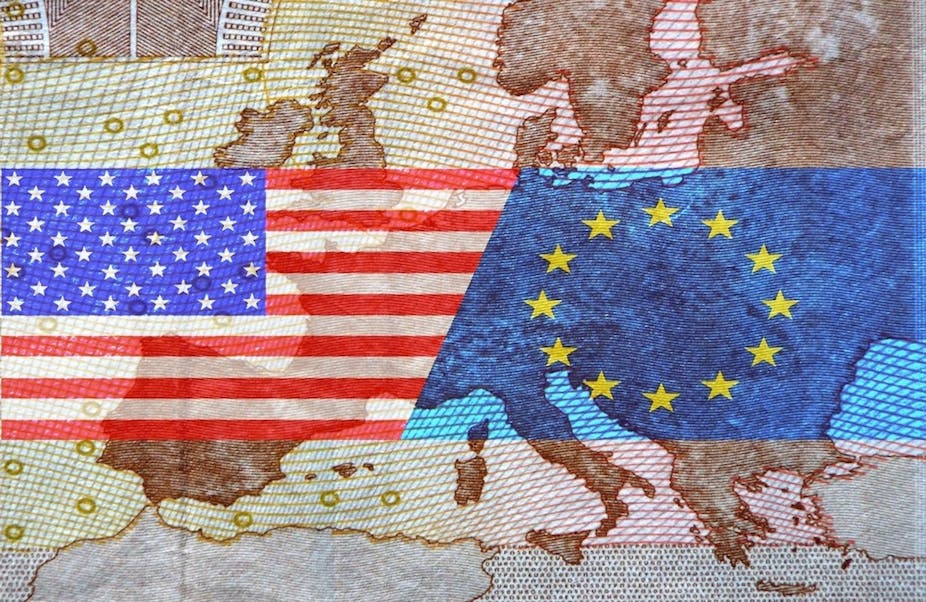Civil society groups have been voicing concerns about the upcoming Euro-American trade deal the Transatlantic Trade and Investment Partnership (TTIP) since it was announced three years ago.
The list of worries includes companies being able to constrain public policy; the potential for weaker consumer and health and safety standards; and the secrecy around the negotiations. Genetically modified (GM) products are one subject on the table, since they fall within TTIP’s broader remit to tackle areas where the US and EU approaches are furthest apart and have therefore been ignored by previous efforts to harmonise regulations. Not surprisingly, perhaps, the potential effect on how GM is regulated is of serious concern.
In the US the share of GM crops, particularly maize and soybeans, has grown steadily over the years – even though support for the technology is not universal. The US has no specific legislation over GM crops, but approves them either through the Food and Drug Administration or via national environmental policy processes, depending on the variety and purpose.
Approvals use a science-based risk assessment, which focuses on whether scientists have identified sufficient risks to justify a ban. Although the federal authorities are the most important in this area, municipal authorities also have jurisdiction over GM to some extent, and some Californian municipalities have banned cultivation, for example. On the other hand, attempts at both federal and state level to force consumer products to carry GM labels have failed.
The European approach
In the EU, applications to approve new crops go to the relevant member state and are then passed to the European Food Safety Authority (EFSA). The EFSA makes a recommendation to the European Commission (EC), which in turn makes a recommendation that is subject to a vote by the member states. These recommendations are based on the precautionary principle – meaning that approvals might be refused if the science is not sufficiently certain about the level of risk involved.
As things stand, only one GM crop has EU approval for cultivation. Imports of consumer products and animal feeds with GM ingredients are permitted, but they must be labelled if the GM content is above 0.9%; and non-GM foods and feeds can display labels signalling that they are GM free.
The reason why so few GM products are permitted is that strong opposition in some member states, including Austria, France, Germany, Hungary, Poland and Italy, led the EC to suspend its approval processes in 1998. To get around this, new regulations introduced last April include opt-out measures so that even if a product is approved at EU level, individual member states can still decide not to allow cultivation or use the product in food or animal feeds in their national territory. This is designed to break the deadlock and allow more pro-GM areas like Spain, Portugal and the English part of the UK to take up these products.
These changes to the rules are linked to a World Trade Organisation (WTO) 2006 ruling against the EU’s approach to granting GM approvals, following pressure from US farming groups and GM manufacturers. The WTO found that most EU member states were unduly slow to deal with approval applications for new GM crops and that a previous pan-EU moratorium on new applications contravened the rules of international trade.

Other US trade agreements
When it comes to predicting what TTIP could mean for the very different approaches to GM in the US and EU, people often look to the other ambitious US trade deal in the making, the Trans-Pacific Partnership, which involves 11 other Pacific Rim countries. From the parts of TPP published so far, environmental groups like Ecowatch are concerned that the section on sanitary and phytosanitary standards could weaken national resolve to control GM through labelling.
Though it doesn’t mention prevention of GM labelling as such, it includes commitments to prevent undue delays on imports of agricultural goods; to limit inspections; and accept that different systems can achieve the same outcome. Meanwhile, the sections on intellectual property include a 10-year data-exclusivity requirement for new agricultural chemical products. This appears to provide an additional economic incentive for GM producers to develop products and push for greater market share.
TPP also pushes for each country to recognise the other signatories’ certification systems for organic products, which raises an analogy with the US-South Korea free-trade agreement of 2011. Following the agreement Korea was forced to adapt its zero tolerance against GM, which had previously meant that to be considered organic in that South Korea, products had to have a 100% guarantee that there was no GM contamination in them. Since certain non-GM organic products from the US could not give that 100% guarantee, they had not previously qualified as organic in Korea. The trade deal meant that if products were labelled organic in the US, they had to be accepted as organic in South Korea.

Because most EU members still oppose GM, it seems highly improbable that the US will be able use the TTIP negotiations to force Europe to dramatically change its position. But GM labelling, which is voluntary in the US, might be the area where the Americans try to exert the most pressure.
TTIP is no doubt generating heated debates behind closed doors. Because the final outcome will depend on trade-offs and linkages across the whole agreement, it is impossible to say how this will affect GM at this stage. And even once we have a published agreement, it will take years before we see how it is implemented and interpreted in practice – just like it will with TPP. All we can say is that it has the potential to have a substantial effect on current regulation. Many people are therefore watching developments closely.
For more coverage of the debate around GM crops, click here.

